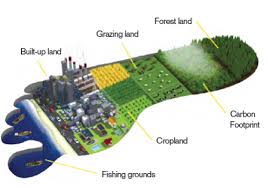The ecological footprint is the earth surface needed to meet the lifestyle of a person or group.
Examples:
the ecological footprint of London is 2 x the area of the UK.
For 1 kg of meat is needed
10 m² pasture for grazing animals
11m ² of arable land for growing fodder
2,4 m² arable land for stables...
21 m² energy land
 As measuring tool the Footprint was introduced in 1992-1993 at the Canadian University of British Columbia by William Rees and Mathis Wackernagel. They provided estimates of how much area of fertile land would be needed to a given population to maintain indefinitely for everything they produce, fossil fuels, water, clean air, place to stock and process waste. This is all available only in a limited extent.
As measuring tool the Footprint was introduced in 1992-1993 at the Canadian University of British Columbia by William Rees and Mathis Wackernagel. They provided estimates of how much area of fertile land would be needed to a given population to maintain indefinitely for everything they produce, fossil fuels, water, clean air, place to stock and process waste. This is all available only in a limited extent.
Calculated according to the current population and the available reserves is 2.1 hectares available per person, which is about three soccer fields. This is the fair share of the earth.
But we use worldwide more than the earth can handle and so are not eco-friendly.
The 'Ecological Footprint' is also a way to measure social justice and respect for the environment.
At the Summit of the United Nations (1992, Rio de Janeiro) and the Rio +10 Summit on Sustainable Development (2002, Johannesburg) was even more obvious that the gap between rich and poor countries is growing, and with it the degradation of the environment and diversity.
Industrialized countries use too many resources from the South, and thus hinder their development. Over-consumption of the rich causes poverty for the poor.
The size of the footprint is composed of biologically productive area (ground or sea) with an relevant activity of photosynthesis and biomass production:
Agricultural land (arable land): used for the production of food, feed, fiber (cotton), rubber, etc. This does not include the impact of agriculture on the environment, soil depletion and erosion unless they in the long term reduce available fruitful soil.
Grassland (pasture and lightly wooded land): for the production of animal products such as meat, milk, wool, leather, etc..
Forests (natural and planted) for wood, fuel, paper, etc..
Fishing grounds: water surface for catching and breeding of fish, mussels, etc...
Built-up land: for houses, streets, infrastructure, shops, factories, generating wind and solar power, water power, etc.. These sites are usually historically productive land.
The energy from fossil fuels is converted into the area needed to absorb CO2 emissions. Because the oceans absorb about 35% of this, this is charged only 65%. As of 2005, nuclear power is no longer offset because the risks, terms and impact cannot be expressed in terms of biocapacity.
Instead of 2,1 ha per year per earthling, man consumes an average of 2.7 ha per year.
From the late 80s we actually consume more than one planet: the biocapacity of the Earth has been exceeded. How can that be?
The earth produces with its natural capital every year interest of which we live. If we use more, we attack the capital! This will allow faster and more deficit.
In Belgium, there is 1.1 hectares per person available. 2014:The ecological footprintis7.45hectaresper Belgian(worldaverage of 1.8haand4.3in Europe). Two yearsago, it was7.14ha. If everyonelived likea Belgian,thenwe would need 4.3 earths.OnlyKuwait,Qatar,the United Arab Emiratesand Denmarkconsume evenmoreearth.
The ecological footprint is an indicator, not an exact science.
But it gives everyone the same fair comparison.
Footprint trackers
You can calculate impact on the environment, calculate your ecological footprint, e.g. with the WWF Calculator
http://www.footprint-wwf.be/footprintpage.aspx?projectId=105&languageId=3
United Arab Emirates 10.7 acres
United States 8.0 acres
Belgium 8.0 acres
Netherlands 6.2 acres
Oceania 5.4 acres
Europe 4.7 acres
Hungary 3.0 acres
Brazil 2.9 acres
World 2.7 hectares
Turkey 2.7 hectares
Latin America and Caribbean 2.6 acres
Asia 1.8 hectares
Available biocapacity 1.8 hectares
Africa 1.4 acres
CO2 Footprint or Carbon footprint: a measure of the CO2 emissions from the use of fossil fuels in transport, production of electricity, heating, etc.. This weighs heavily in the Footprint, approx 30%: for Belgium and Luxembourg for example, 2.75 ha, 2.78 ha for the Netherlands (2003)
Earth Overshoot Day: this is the date from January 1 - counted when humanity has consumed more of the earth than the earth itself can produce in one year.
For example, in 2013 it was August 20. The 132nd day, 133 more to go. So we draw more than 50% of the natural resources of future generations.
LCD TVs consumes 77 kWh / yr, more than an Ethiopian (52kWh). A washer (118) over a Tazanian, an electric oven (210) over a Nigerian (136), a dryer (370) over a Kenyan and an energy efficient refrigerator (459) over a Ghanaian (300) according to data from September 2013. The average American consumed 13,395kWh/jr.
